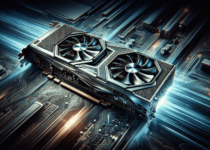What Motherboard do I have? Find out Now
Say hello to the heart and soul of your computer, the motherboard! For some, it’s a mystery concealed behind a steel panel; for others, it’s an intricate system of circuits that bring digital dreams to life. Regardless of how you perceive it, you might be wondering What motherboard do I have? – and we’re here to help you uncover this enigma. This article is your roadmap through the labyrinthine world of motherboards.
Before delving deeper into this tech labyrinth, let’s briefly answer the question at hand: discovering what motherboard you have is as simple as opening a few settings on your device or installing a quick system information tool. This knowledge can be pivotal for future upgrades or troubleshooting issues with your machine. Let’s delve in deeper together–welcome to the world inside your computer!
Importance of Knowing Your Motherboard
Knowing your motherboard is essential for various reasons, as it serves as the central hub connecting all major components within your computer system. Firstly, understanding the motherboard’s model and specifications is crucial when upgrading or replacing hardware components, such as the CPU, RAM, or graphics card, to ensure compatibility and optimal performance. Identifying the motherboard also facilitates the installation of the correct drivers, which is vital for stable and efficient system operation.
Additionally, troubleshooting hardware issues, diagnosing problems, and seeking technical support becomes significantly more straightforward when armed with accurate motherboard information. Moreover, knowledge of the motherboard model aids in overclocking endeavors for users seeking to push their system’s performance limits, as different motherboards offer varying levels of support and features for overclocking. In essence, knowing your motherboard empowers you with the information needed to make informed decisions, troubleshoot effectively, and maximize the potential of your computer system.
Ways to Identify Your Motherboard Model
Identifying your motherboard model can be useful for various reasons, such as upgrading hardware, finding compatible drivers, or troubleshooting issues. Here are several methods you can use to identify your motherboard model:
System Information Utility
The System Information utility on Windows is a valuable tool that offers users a detailed insight into the hardware and software components of their computers. To access this utility:
Press Win + R to open the Run dialog:
- This keyboard shortcut opens the Run dialogue box, allowing you to execute commands quickly.
Type msinfo32 and press Enter:
- In the Run dialog, enter the command “msinfo32” and hit Enter. This command launches the System Information utility.
Navigate to the “System Summary” section:
- Once the System Information utility is open, you’ll find a menu on the left-hand side. Click on “System Summary” to access a comprehensive overview of your system.
Look for “System Manufacturer” and “System Model”:
- Within the “System Information” category, specifically under “System Summary,” you’ll find key information about your computer. Look for “System Manufacturer” and “System Model” entries.
- The “System Manufacturer” field identifies the company that produced your motherboard, while the “System Model” field provides the specific model name of your motherboard.
Command Prompt
The Command Prompt provides a powerful interface for accessing system information, and the Windows Management Instrumentation Command-line (WMIC) is particularly useful for gathering details about your motherboard. Here’s a breakdown of the steps:
Open the Command Prompt:
- Press Win + R to open the Run dialogue.
- Type “cmd” and press Enter. This action launches the Command Prompt.
Type the WMIC Command:
- In the Command Prompt window, type the following command:
- “wmic baseboard get product, manufacturer, version, serial number”
- Press Enter to execute the command.
Review the Output:
- The output of the WMIC command will display relevant information about your motherboard.”Product” provides the product name or model of your motherboard.
- “Manufacturer” reveals the company that produced the motherboard.
- “Version” indicates the motherboard’s version or revision.
- “SerialNumber” shows the unique identifier assigned to your motherboard.
CPU-Z
CPU-Z is a user-friendly third-party utility that offers a detailed overview of various hardware components in your computer. Here’s a step-by-step guide on how to use CPU-Z to identify your motherboard model:
Download and Install CPU-Z:
- Visit the official CPU-Z website at https://www.cpuid.com/softwares/cpu-z.html.
- On the website, locate the “Download” button and select the appropriate version for your operating system (Windows).
- Once the download is complete, run the installer to install CPU-Z on your system. Follow the on-screen instructions for a standard installation.
Launch CPU-Z:
- After installation, open CPU-Z by either clicking on the desktop shortcut or finding it in your Start menu.
Navigate to the “Mainboard” Tab:
- In the CPU-Z interface, you’ll see several tabs at the top. Click on the “Mainboard” tab to access information specific to your motherboard.
Speccy
Speccy is a reliable system information tool that provides users with detailed insights into the hardware components of their computers. Here’s a step-by-step guide on how to use Speccy to identify your motherboard model:
Download and Install Speccy:
- Visit the official Speccy website at https://www.ccleaner.com/speccy/download.
- On the website, locate the “Download” button and select the appropriate version for your operating system (Windows).
- After the download is complete, run the installer to install Speccy on your system. Follow the on-screen instructions for a standard installation.
Launch Speccy:
- Once the installation is complete, open Speccy by either clicking on the desktop shortcut or finding it in your Start menu.
Navigate to the “Motherboard” Category:
- In the Speccy interface, you’ll find various categories on the left side. Click on the “Motherboard” category to access information specific to your motherboard.
Open the Case
Opening your computer case to inspect the motherboard physically is a straightforward method for identifying its model. Here’s a more detailed explanation of the steps involved:
Power Off and Disconnect:
- Ensure your computer is powered off completely.
- Disconnect the computer from the electrical outlet to ensure safety during the inspection.
Ground Yourself (Optional):
- Before touching internal components, it’s a good practice to ground yourself to discharge any static electricity. You can do this by touching a grounded metal object or wearing an anti-static wrist strap.
Open the Computer Case:
- Identify the screws or latches securing the side panel of your computer case.
- Remove the screws or release the latches to open the side panel. The method varies depending on the case design.
Locate the Motherboard:
- Once the case is open, locate the motherboard inside. The motherboard is the large, flat circuit board typically mounted parallel to the bottom of the case.
Identify the Model Number:
- Examine the surface of the motherboard for a printed model number. The model number is usually near the center or edges of the board.
- It may be printed on the PCB (printed circuit board) itself or a sticker attached to the motherboard.
Check the Manual or Original Packaging:
- If you have the manual or original packaging that came with your computer or motherboard, it often contains information about the motherboard model. Here’s what you can do:
- Check the manual for a section that provides details about the motherboard.
- If you have the original packaging, look for labels or stickers that indicate the motherboard model.
- The model information is usually printed on a label attached to the manual or packaging.
BIOS/UEFI
Accessing the BIOS (Basic Input/Output System) or UEFI (Unified Extensible Firmware Interface) settings is a fundamental method for obtaining information about your motherboard. Here are detailed steps on how to do this:
Restart Your Computer:
- Save any open files and restart your computer. You can do this by clicking on the Windows Start menu, selecting the power icon, and choosing “Restart.”
Press the Key to Enter BIOS/UEFI:
- During the early stages of the computer’s boot process, you need to press a specific key to access the BIOS/UEFI settings. The key to enter these settings is typically displayed on the screen during the boot process. Common keys include:Del (Delete)
- F2
- F10
- Esc (Escape)
Press the Key Repeatedly:
- As soon as you see the message indicating which key to press (usually on the computer’s splash screen), start pressing the specified key repeatedly. Do this until the BIOS/UEFI menu appears.
Navigate Through the Menus:
- Once you successfully enter the BIOS/UEFI settings, you’ll be presented with a menu system. The interface may vary depending on the motherboard manufacturer.
- Use the arrow keys on your keyboard to navigate through the menus.
Find Information About the Motherboard:
- Look for a section that provides information about the motherboard. The model number is typically displayed in this section. The exact location and naming of this section can vary, but it often includes terms like “System Information,” “Mainboard,” or “Advanced.”
- Use the arrow keys to navigate to the relevant section and view the details.
Exit and Save Changes (if necessary):
- After obtaining the needed information, navigate to the “Exit” or a similar menu option.
- Follow the on-screen instructions to exit the BIOS/UEFI settings. In some cases, you may be prompted to save changes; if you haven’t made any changes, choose the option to exit without saving.
Online System Information Tools
Online system information tools offer a convenient way to detect and display detailed information about your computer’s components, including the motherboard. Here’s a guide on how to use them:
Visit the Website of the Tool:
- Choose the online tool you want to use, such as CPUID or TechPowerUp.
- In this example, let’s use CPUID. Visit the CPUID website at https://www.cpuid.com/softwares/cpu-z.html.
Download and Run the Tool:
- On the website, locate the “Download” button for the chosen tool.
- Download the tool and run the installer or executable file. Follow the on-screen instructions to install or launch the tool.
Run the Tool in the Browser (if applicable):
- Some online tools, like TechPowerUp’s system information utility, may run directly in your web browser without requiring installation.
- For these tools, visit the respective website and look for an option to start the tool. Follow any on-screen instructions provided.
Allow System Scan:
- Once the tool is launched, it will usually initiate a system scan to gather information about your computer’s components.
- Allow the tool to complete the scan. This process may take a few moments.
View Detailed Information:
- After the scan is complete, the tool will present a detailed overview of your system information, including details about your motherboard.
- Look for sections or tabs related to the motherboard. Information such as the manufacturer, model, and chipset should be readily available.
Device Manager
Device Manager is a built-in Windows tool that allows you to view and manage hardware devices connected to your computer. While it may not provide the exact motherboard model, it can give you information about the chipset. Here’s how to access Device Manager:
- Right-click on the Start button and select “Device Manager.”
- Expand the “System devices” category.
- Look for an entry related to the motherboard or chipset. The name may vary, but it often includes terms like “chipset” or “motherboard resources.”
Final Thoughts
In conclusion, determining the type of motherboard you have is invaluable for various reasons, including upgrading your computer’s hardware or troubleshooting certain issues. With the methods discussed in this article, such as using system information software or physically inspecting your PC, you can easily identify your motherboard model.
Remember that each approach has its advantages and should be chosen based on your comfort level and technical expertise. Your motherboard is the backbone of your computer, so understanding it can give you more control over your device’s performance and lifespan. Always handle this component with care and consider professional assistance if in doubt to ensure the longevity of your equipment.
FAQs
Is there any software to help identify my motherboard?
Yes, third-party software such as CPU-Z, Speccy, or HWiNFO can provide detailed information about your motherboard.
Can I upgrade my RAM without knowing my specific motherboard model?
It’s important to know your motherboard model before upgrading RAM to ensure compatibility with memory type and speed.
Are all motherboards compatible with all CPUs?
No, different motherboards support different types of processors depending on their socket types. It’s crucial to check CPU-motherboard compatibility before making any upgrades or purchases.
Does knowing my Motherboard model help when installing new drivers?
Yes! Knowing your specific Motherboard model will allow you to download appropriate and updated drivers directly from the manufacturer’s website.


